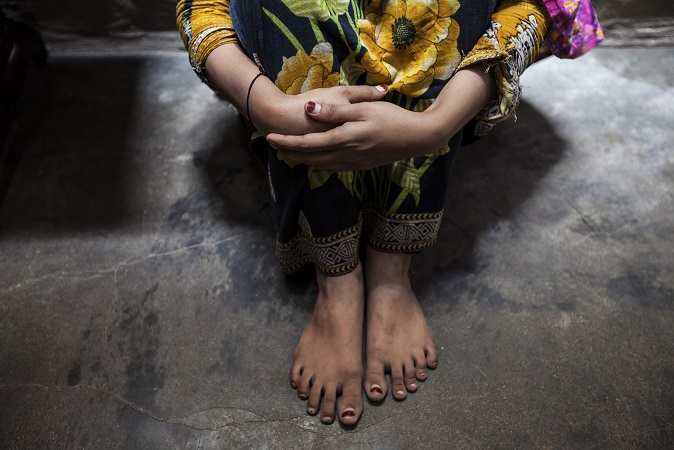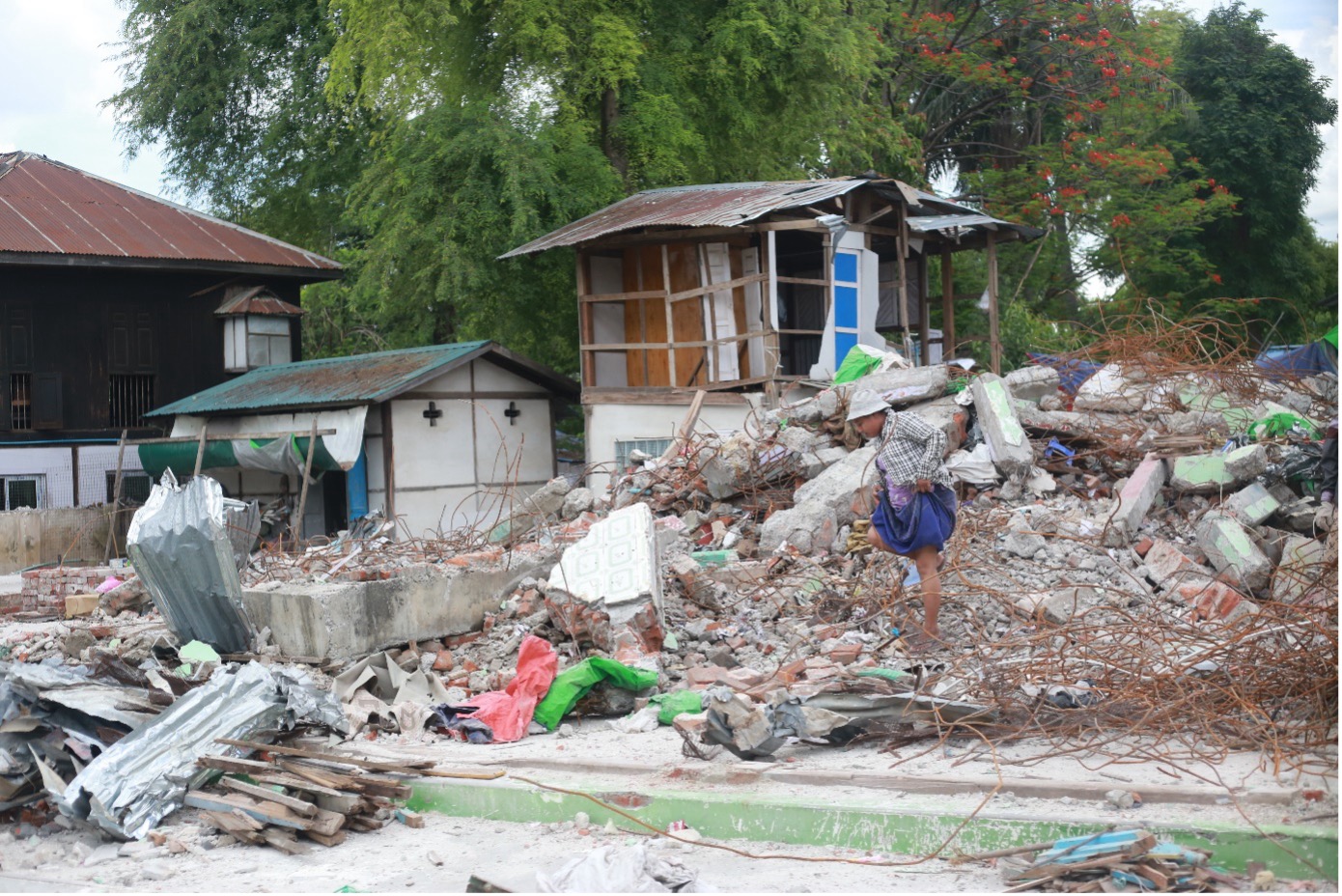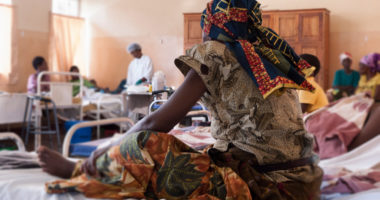Thirty years ago today, 23 women launched the ‘16 Days of Action’ against gender-based violence.[1] Each year, this campaign begins on the 25th of November (International Day for the Elimination of Violence against Women) and ends on the 10th of December (Human Rights Day) to symbolically link these two days. In the three decades since, much has been achieved – we now have many international commitments and plans of action to eliminate gender-based violence. A critical component of these is the modification of domestic legislation.
In this post to mark the 30th campaign of the 16 Days of Action, Rachael Kitching, Vanessa Murphy and Kelisiana Thynne of the ICRC legal division unpack the ICRC’s Checklist on the Domestic Implementation of International Humanitarian Law (IHL) Prohibiting Sexual Violence. The Checklist sets out State responsibilities regarding the criminal repression of sexual violence as a war crime, as well as examples of good practice for service accessibility and special measures of protection. It presents easy-to-follow guidance to assist States and the Red Cross and Red Crescent Movement to identify and address legislative gaps.
The prohibition of sexual violence is well-established in international law, but it continues to occur with frequency and impunity whether in wartime, at work or in homes.
The international community knows why: look no further than UN Security Council Resolution 2667 (2018) for a surgical analysis of drivers, exacerbators, and root causes. The international community also knows what needs to be done: the list of legal, political and humanitarian commitments is almost the length of the alphabet, each a hard-earned landmark (Additional Protocols, Beijing Platform for Action, Belém do Pará, CEDAW, Deeds of Commitment, the Geneva Conventions, GBV Call to Action, humanitarian pledges, Istanbul Convention, Maputo Protocol, National Action Plans, PSVI Declaration of Commitment, Red Cross and Red Crescent Conference Resolution, Rome Statute, SDG 5.2, Vienna Declaration, WPS resolutions).
The question now is whether we will do what we have committed to doing. Resources are needed for the long-haul work of turning the words of international law, resolutions and roadmaps into technical-level reality. Put it another way: implementation, implementation, implementation.
The focus of this blogpost is one strand (among others) of that implementation: ensuring that domestic laws reflect international obligations and create conditions conducive to survivors coming forward. This modification of domestic law is called for by the international commitments listed above (see UNSCR 2467 OP3, RCRC Resolution OP7 and 22) and is critical for domestic-level prosecutions gathering promising steam (Seelinger here and here). This year it has been placed centre-stage by the Model Legislative Provisions on the Prosecution of Conflict-Related Sexual Violence from the UN Special Representative on the topic, a model law on rape from the UN Special Rapporteur on Violence Against Women, and the ICRC’s Checklist for the Domestic Implementation of IHL Prohibiting Sexual Violence.
A tool to identify gaps in domestic law: The ICRC Checklist
The ICRC Checklist was developed in consultation with the Red Cross and Red Crescent (RCRC) Movement Working Group on Sexual and Gender-Based Violence and aims to equip Movement and State legal advisers to improve domestic laws related to sexual violence in armed conflict. The Movement is a well-established engine at domestic level: RCRC National Societies support their governments in their capacity as national auxiliaries in the humanitarian field, and as part of its Strategy on Addressing Sexual Violence, the ICRC is committed to providing technical support to authorities for domestic implementation of international obligations. The ICRC Advisory Service on IHL is a network of lawyers across our delegations working to do exactly this.
The Checklist summarises State obligations to prevent and respond to sexual violence in their domestic law. Critically, in addition to IHL obligations it contains relevant international human rights law as well as examples of good practice beyond hard law; recognizing that key to galvanizing legislative change will be harnessing the protective potential of overlapping frameworks.
The Checklist is also closely informed by State practice, setting out examples of how different States have already implemented their obligations in each sub-section. Here, you’ll see that domestic law and procedures take various forms when implementing international law obligations.
We’ve also strived to be concise. The Checklist questions address key themes – the prohibition of sexual violence in conflict and peacetime, definitions, accessibility of support services, special measures of protection for groups facing particular risks, penalties, remedies, selected issues and criminal repression – and limits guidance on each to one page.
Here we take a closer look at three Checklist topics – definitions, accessibility of support services and justice processes, and general requirements for domestic criminal repression.
1. Narrowing the gap: Definitions of sexual violence
Non-exhaustive definitions that capture coercion. The Checklist begins with guidance on definitions of key terms. Based on case law and State practice, we’ve highlighted the broad definitional elements of sexual violence that are important to reflect in domestic law, and stipulated that lists of prohibited acts should be non-exhaustive (Checklist Questions 3.A and 3.B).
Definitions free from stereotypes. Gender-stereotyping of perpetrators and victims often manifests in domestic legal provisions and hampers justice (see this paper by the International Commission of Jurists). Perpetrators may be defined as men, and victims are too often defined exclusively as women and girls, for example in domestic legal definitions that define rape exclusively as vaginal rape. Other assumptions are made about the combatant or civilian status of the victim and perpetrator; it is a misconception that a war crime can only be committed by a person in uniform against a civilian. The Checklist clarifies that in armed conflict any civilian or combatant, of any gender, can be the perpetrator or the victim of sexual violence. Definitions of sexual violence must therefore be inclusive, avoiding limitations on the gender or status of the victim and perpetrator (Checklist Questions 3.D and 3.E).
Contemporary understanding of armed conflict nexus. The Checklist also recommends a contemporary understanding of when sexual violence occurring within the temporal scope of armed conflict will constitute a war crime. Sexual violence is a war crime, meaning that IHL applies to the act, when there is sufficient ‘nexus’ (connection) between the act and an armed conflict. In the Checklist, we set out a contemporary interpretation of this nexus, including in cases of intra-party sexual violence (conduct involving members of the same party). This contemporary interpretation reflects the approach of the ICRC’s Commentary on Common Article 3, and takes account of the International Criminal Court’s Ntaganda judgment of 2017 (for some of the related debates, see here, here and here), which narrowed the gap between cases of inter-party and intra-party sexual violence (Checklist Question 3.C).
2. Gaps in access and reporting: Support services and justice
Access to care. States have obligations to provide victims/survivors of sexual violence with the medical care, including mental health care, that they require: physical and mental health are often at the forefront of survivor’s needs, and domestic law can play an important role in recognizing this entitlement and ensuring access (Checklist Question 4.A). Authorities should also review the effectiveness of any mandatory reporting requirements to ensure they do not deter access to care (Checklist Question 8.A).
Protection from counter-charges. Risks of facing counter-charges pose significant barriers for victims/survivors of sexual violence. Counter-charges can occur based on laws that criminalize acts such as adultery even where the act is non-consensual, or homosexuality. Such laws mean that in certain circumstances, the victim may face criminal charges themselves when they report sexual violence, thereby deterring reporting.
Special measures of protection, confidentiality, and training. Despite its global prevalence and grave consequences, sexual violence remains underreported everywhere.[2] Survivors don’t report for many reasons, including stigma, intersecting forms of discrimination, and potential retaliation. Reporting is also hindered by more procedural factors such as poorly resourced legal systems, costly access, and risk of breaches of confidentiality.[3] During armed conflicts or other situations of violence, obstacles are even more pronounced, as infrastructure breaks down and access is further hindered by e.g. road blocks and check points, and insecurity.[4] It’s therefore of foundational importance that States take steps to ensure that reporting is accessible for all survivors. This may include putting special measures in place for categories of victims/survivors facing specific risks, including children, women, detainees, and migrants; ensuring respect for the privacy of the victim/survivor through confidentiality measures; and providing specialized training to bodies responsible for investigating sexual violence cases (Checklist Section 5).
3. Closing the impunity gap: Criminal repression of sexual violence, including as a war crime
States must give their national courts the jurisdiction and legal basis to try sexual violence, both in peacetime and in wartime, and should do so expressly as a war crime. Prosecutions of these crimes need to be a priority; impunity is too often the norm, and sexual violence has only increased during the COVID pandemic and other emergencies (see Sophie Sutrich’s blog).
Focusing on international law applicable in armed conflict, the Checklist sets out the numerous provisions in the Geneva Conventions, Additional Protocols and customary law that explicitly or implicitly prohibit sexual violence. Particularly significant is the inclusion of sexual violence under the war crime provisions (Art. 85 AP I, Rule 156 CIHL Study of 2005), including the grave breaches (Art. 49 GC I, Art. 50 GC II, Art. 129 GC III, Art. 146 GC IV, ICRC Updated Commentary (2017), paras. 2966 and 2968, ICRC Updated Commentary (2018), para. 3095, ICRC Updated Commentary (2020), para. 5249).[5] These provisions correspondingly require the criminal repression of sexual violence in armed conflict, with implications for domestic law set out in the Checklist.
For example, the Checklist recommends that sexual violence be expressly criminalized as a war crime (as compared to a peacetime domestic crime) in both international and non-international armed conflicts (Checklist Section 2). What’s more, penalties must reflect the gravity of the offence, appropriate remedies must be granted to victims/survivors, statutes of limitations must not be applied, and States can provide for universal jurisdiction in their legislation for sexual violence as a war crime (Checklist Sections 6, 7 and 9).
Time to walk the talk
Impunity persists when national courts are not afforded the legislative tools to prosecute sexual violence occurring in armed conflict, and when victims/survivors are not afforded the conditions needed to report and care to meet their needs. The implementation of international legal obligations through appropriate domestic law and procedures, with the aid of the new ICRC Checklist, will help to: prevent negative societal and procedural factors from arising; eliminate obstacles to accessing support services and to reporting; and can, in turn, help us to prevent impunity for sexual violence in armed conflict and other emergencies.
In the last thirty years we have acquired the norms, the tools, and the words we need to eliminate sexual violence. Now it’s time for the nit and grit of concrete domestic legislative change. Our rallying cry for this 16 Days of Action and beyond is: implementation, implementation, implementation.
[1] During the first ever Women’s Global Leadership Institute conference of 1991, 23 women from various countries gathered together to launch the ‘International Campaign of 16 Days of Activism Against Gender Violence’. The goals of the campaign “were to build more awareness of gender violence globally, create consciousness of it as a human rights violation, and facilitate greater networking among women leaders working in this area. See Center for Women’s Global Leadership, ‘Women, Violence and Human Rights: 1991 Women’s Leadership Institute Report’ (1991), p. 63.
[2] See ICRC, ‘Special Appeal’, 2021, p. 10.
[3] See ICRC, ‘Special Appeal’, 2021, p. 10.
[4] See ICRC, ‘Special Appeal’, 2021, p. 10.
See also
- NG’AA Michael Mwendwa, Disability and sexual violence in the COVID-19 era, December 3, 2020
- May Maloney, Sexual violence in armed conflict: can we prevent a COVID-19 backslide?, November 25, 2020
- Sophie Sutrich, COVID-19, conflict and sexual violence: reversing the burden of proof, June 19, 2020
- Helen Durham, Shining a spotlight on sexual violence in war: The 2018 Nobel Peace Prize, October 11, 2018








Comments